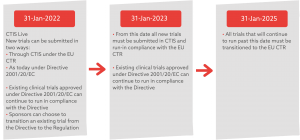European Union Clinical Trial Regulation 536/2014 (EU CTR) became applicable on January 31, 2022 and has introduced a more centralized approach to clinical trial conduct in the EU, enhanced transparency requirements, and a new GMP framework for Investigational Medicinal Products (IMPs).
Almac Clinical Services is ready to support delivery of your investigational products as you navigate the transition from Directive 2001/20/EC to Regulation 536/2014 and will continue to support the delivery of investigational products in the EU and beyond.
Almac provides industry leading solutions for clinical trials globally, including:
Frequently Asked Questions
What is the Clinical Trial Information System?
The Clinical Trial Information System (CTIS) is the central database for clinical trials in the European Union (EU). This central system will streamline the communication between sponsors and regulatory authorities in the EU and support the transparency of information required by the EU CTR.
CTIS will be used:
- By sponsors to submit applications for new or transitioning clinical trials, respond to information requests, submit substantial modifications, and to submit clinical study data.
- By regulatory authorities in the EU to review applications for clinical trials, substantial modifications, request information from sponsors, and review clinical study data.
- By the public to access information about clinical trials in the EU.
What is EU CT Regulation and what happens when this becomes applicable on January 31, 2022?
EU CT Regulation (EU CTR) was passed in April 2014 and is intended to streamline the conduct of clinical trials in the European Union (EU), while also enhancing patient safety and transparency of information around clinical trials.
A key feature of the Regulation, the Clinical Trial Information System (CTIS) was designed to facilitate these goals. The development and independent audit of the CTIS took until early 2021 and delayed full implementation of the Regulation.
When the CTIS goes live on January 31, 2022, the Regulation becomes applicable and replaces Directive 2001/20/EC. This also marks the start of the transitional arrangements from the Directive to the Regulation .
What are the transitional arrangements from Directive 2001/20/EC to Regulation 536/2014?

What trials should be transition from Directive 2001/20/EC to Regulation 536/2014? (Updated August 2022)
Trials that fall into either of these two categories must be transitioned to the CTR:
- Trials that will still be running in any EU member state on January 30, 2025
- Trials where the sponsor wants to add an EU member state after January 30, 2023
It is important to note that if a clinical trial which is running under the Directive will be complete in all EU member states by January 30, 2025, it does not have to transition to the EU CTR. It can complete under the Directive. End of trial must be notified in all EU member states where the trial was being conducted. The clinical trial could still be running in non-EU countries on or after January 31, 2025; this would not require it to transition in the EU. The transition periods only apply to EU member states, so it is the status of the trial in EU member states that will either allow the trial to complete under the Directive or transition to the CTR.
For the second point, it is important to note that the option to make any submissions directly to an EU member state under the Directive ends on January 30, 2023. This means that if the sponsor for a trial that is running under the Directive after January 30, 2023 wants to add an EU member state, it will be necessary to transition the trial to the CTR first, then the submission to add a member state can be made under the CTR. Sponsors conducing trials under the Directive, who intend to complete the trial under the Directive without transitioning, should ensure that applications have been made to all Member States by January 30, 2023.
When should EU trials be transitioned from Directive 2001/20/EC to Regulation 536/2014? (Updated August 2022)
This decision will need to be made by sponsors for each of their EU clinical trials. Sponsors will need to assess each clinical trial to determine impact to the clinical trial of continuing that trial under Directive 2001/20/EC or transitioning the trial to Regulation 536/2014. Once a trial is transitioned to Regulation 536/2014, it must fully comply with the requirements of the Regulation.
Any clinical trials that are expected to still be running in at least one EU member state on 30-JAN-2025 must be transitioned to Regulation 536/2014 before that date.
How are existing EU clinical trials transitioned from Directive 2001/20/EC to Regulation 536/2014? (Updated August 2022)
To transition an existing EU clinical trial that was approved and commenced under Directive 2001/20/EC, there are potentially two steps to the transition process.
First, the sponsor must ensure the documents for the trial are compliant with the CTR. For example, the Protocol for a clinical trial running under the Directive could be different between participating EU Member States. The sponsor must harmonize the clinical trial documents and submit the updated documents to each participating Member State as a Substantial Amendment. Once the Substantial Amendment is approved, then the sponsor can submit the clinical trial for approval in CTIS. The clinical trial will be reviewed in accordance with the CTR and approval must be received in CTIS to transition the clinical trial.
The CTR Questions & Answers document has a section on transition of clinical trials that contains a lot of valuable information for sponsors on how to transition trials. This document also makes it clear that investigation product that was QP Certified before the transition can continue to be utilized following the transition. Supplies will need to be labeled in compliance with Annex VI of the CTR for any packaging campaigns performed after the transition of the clinical trial to the CTR.
What are Auxiliary Medicines? (Updated August 2022)
Auxiliary Medicines (AxMPs) are medicinal products that are “used for the needs of a clinical trial as described in the protocol, but not as an investigational medicinal product.” (EU) No 536/2014, Article 2(8)
Examples of Auxiliary Medicines are rescue medication, challenge agents, medicinal products used to assess endpoints in the clinical trial, or background treatment. They must be relevant to the design of the clinical trial and their use must be described and justified in the clinical protocol.
The regulation is also clear that concomitant medications are not Auxiliary Medicines. Concomitant medications are unrelated to the clinical trial and not relevant to the design of the clinical trial.
More detail can be found in the “Auxiliary Medicinal Products for Clinical Trials” document. Auxiliary Medicinal Products in Clinical Trials (28 June 2017)
What requirements are outlined for Auxiliary Medicines? (Updated November 2022)
The regulation states that Auxiliary Medicines should be authorized in the EU, meaning a medicinal product which has a Central EU Authorisation or is authorized in a Member State Concerned (MSC). A MSC is defined in the regulation as an EU Member State where an application to conduct a clinical trial has been submitted.
If a sponsor wants to use an unauthorized Auxiliary Medicine, this must be justified in the clinical protocol as part of the submission for approval and approved by the Member State(s) where the trial will be conducted. The regulation is also clear that cost is not an acceptable justification for the use of an unauthorized Auxiliary Medicine. If the use of an unauthorized Auxiliary Medicine is approved, there are specific labeling requirements, in addition to controls required for traceability, accountability and destruction.
What requirements are outlined for unauthorized Auxiliary Medicines? (Updated August 2022)
The regulation states that if unauthorized Auxiliary Medicines are used for a clinical trial, they must be manufactured according to EU GMP standards or equivalent. In addition, arrangements for traceability, returns and destruction of unauthorized Auxiliary Medicines must be equivalent to those in place for investigational products. There are also specific labeling requirements for unauthorized Auxiliary Medicines detailed in Annex VI of the regulation.
What are the major changes for clinical trials under the EU CT Regulation? (Updated September 2022)
- A single, central application and decision for EU clinical trials, through the Clinical Trial Information System (CTIS) portal
- Use of CTIS for Substantial Modifications and submission of clinical trial results
- A new framework for GMP of Investigational Medicinal Products (IMPs), further segregating GMP in EU with specific GMP for IMP requirements through:
- Delegated Regulation 2017/1569 – GMP of IMPs
- Detailed Guidelines for GMP of IMPs
- During transition, the GMP framework to be followed will align with the legal framework that the clinical trial is being conducted under. Trials submitted and approved under the EU CT Regulation will follow the new framework detailed above. Trials submitted and approved under the Directive will continue to follow Annex 13.
- Updated template for Qualified Person (QP) batch certification to align with the new GMP framework
- Introduction of Auxiliary Medicinal Products (AxMPs), which replace Non-Investigational Medicinal Products (NIMPs), along with stricter control of these products in EU trials
- Enhanced traceability, returns, accountability and destruction requirements for IMPs and unauthorized AxMPs
- Centralized clinical label text requirements in Annex VI, with the recent European Commission adoption of a revision to Annex VI to amend expiry date requirements (see next question for details)
- Enhanced sponsor reporting to EU regulatory authorities
- 25-year retention requirement for the Trial Master File
What are the changes to labeling requirements under the EU CT Regulation 536/2014? (Updated November 2022)
Labeling requirements are laid out in Annex VI of the EU CTR. This Annex details requirements for:
- Investigational Medicinal Products (IMPs) (includes comparator products)
- Unauthorized Auxiliary Medicinal Products (AxMPs)
- Authorized IMPs
On 06-Sep-2022, the European Commission adopted a revision to Annex VI label text requirements that bring them into close alignment with Annex 13. This was done via Delegated Regulation (EU) 2022/2239, which was published in the Official EU Journal on 15-Nov-2022 and will enter into force on 05-Dec-2022.
Once applicable, the revision will allow the expiry date to be omitted from the immediate container in specific situations:
- When the immediate container will remain with the outer container
- When the immediate container is small and has limited space for label text
In both cases, the immediate container must be provided with an outer container that has the expiry date printed on the label.
Annex VI also allows for the information on the label to be managed through alternative means, such as a central IXRS system, however some particulars cannot be omitted from labels. It never allows for the expiry date to be omitted from the outer container label. Allowances to exclude the expiry date from the immediate container label of IMP or AxMP are aligned with the specific circumstances detailed above.
This revision will make management of expiry updates significantly easier – whenever the immediate container is packaged and supplied with a labeled outer container, it will likely be possible for the sponsor to justify the omission of the expiry date from the immediate container.
Source: EU CTR (Annex VI on pages 72-74)




